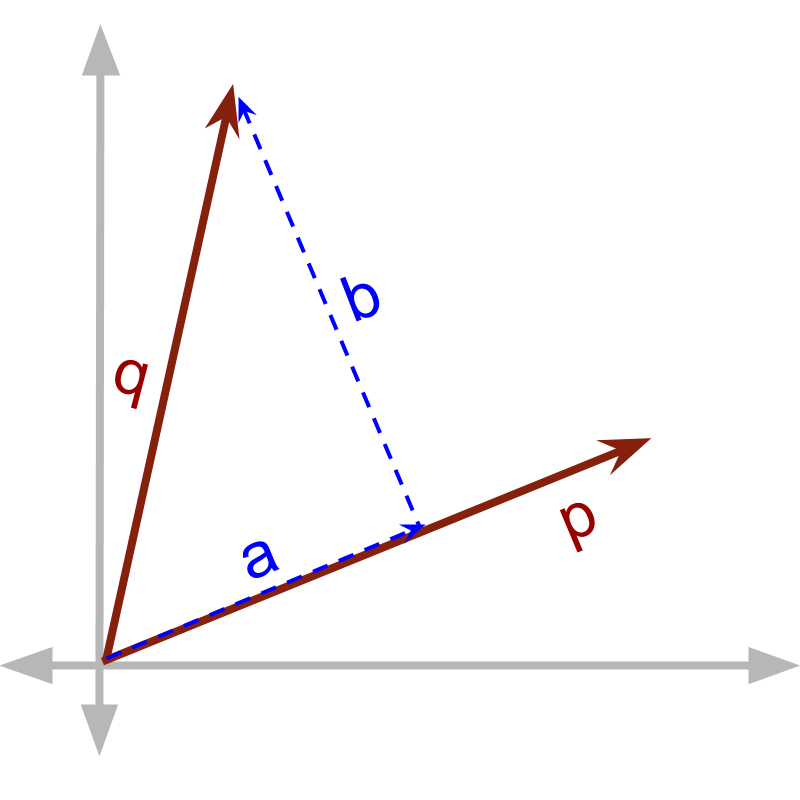
what you'll learn...
Overview
Multiplication of Vectors
» Two products because of orthogonality of components of vectors
 → dot product is defined for components in parallel
→ dot product is defined for components in parallel
→ cross product is defined for components in perpendicular
two forms of multiplication
The fundamental operations of mathematics are Addition, Subtraction, Multiplication and Division.
Addition is combining two quantities and measuring the combined quantity.
Subtraction is the inverse of addition.
There are two forms of multiplications. We'll explain this.
Division is the inverse of multiplication.
A person takes apples and places them in his basket. He repeats that times in total. Effectively, the person has apples. In this, scalar quantity is repeatedly added times to get result .
A scalar quantity can be added repeatedly.
Repeated addition is a form of multiplication.
A person takes oranges that costs coins each. The person has to pay coins for the fruits. The scalar quantity multiplies with another scalar quantity .
Two different scalar quantities can be multiplied.
Note: In this example, the number of oranges is forming a count equivalent to multiply the cost. Instead consider, force equals mass multiplied acceleration. In this, the mass and acceleration are multiplied. Neither of them is mapped to count equivalent.
We have studied about vector addition and multiplication of
vectors by a scalar.
Is there something as multiplication of a vector by another vector?
That is the subject of learning in these pages. Let us go through some basics to understand vector multiplication.

Consider the and shown in figure. is split into and , such that
and
is in parallel to
is in perpendicular to
The vectors and interact to form a product. In this multiplication, either one of and takes part. Remember the orthogonality of directions. When vectors interact to form products the interaction is either with the component in parallel or the component in perpendicular.
When two vector quantities interact to form a product, either one of the (1) component in parallel or (2) component in perpendicular is involved in the multiplication. In practical scenarios, when one component interacts, the other component does not interact and is lost in the product.
summary

How does direction affect vector quantities in multiplication?
At an abstract level, there are two products possible. Given multiplicand and multiplier . is split into and , such that
and
is in parallel to
is in perpendicular to
two forms of multiplications are defined for each of these two components.
• one with component in parallel to the other, called vector dot product.
• another with component in perpendicular to the vector, called vector cross product.
Outline
The outline of material to learn vector-algebra is as follows.
Note: Click here for detailed outline of vector-algebra.
• Introduction to Vectors
→ Introducing Vectors
→ Representation of Vectors
• Basic Properties of Vectors
→ Magnitude of Vectors
→ Types of Vectors
→ Properties of Magnitude
• Vectors & Coordinate Geometry
→ Vectors & Coordinate Geometry
→ Position Vector of a point
→ Directional Cosine
• Role of Direction in Vector Arithmetics
→ Vector Arithmetics
→ Understanding Direction of Vectors
• Vector Addition
→ Vector Additin : First Principles
→ Vector Addition : Component Form
→ Triangular Law
→ Parallelogram Law
• Multiplication of Vector by Scalar
→ Scalar Multiplication
→ Standard Unit Vectors
→ Vector as Sum of Vectors
→ Vector Component Form
• Vector Dot Product
→ Introduction to Vector Multiplication
→ Cause-Effect-Relation
→ Dot Product : First Principles
→ Dot Product : Projection Form
→ Dot Product : Component Form
→ Dot Product With Direction
• Vector Cross Product
→ Vector Multiplication : Cross Product
→ Cross Product : First Principles
→ Cross Product : Area of Parallelogram
→ Cross Product : Component Form
→ Cross Product : Direction Removed